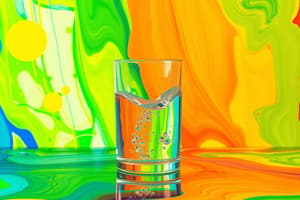Podcast
Questions and Answers
Which of the following is not a unique property of water?
Which of the following is not a unique property of water?
- Water cools rapidly (correct)
- Frozen water floats
- Water retains a large amount of heat
- Water molecules stick to each other
What is the pH range of acidic solutions?
What is the pH range of acidic solutions?
- Less than 7 (correct)
- Between 7 and 14
- More than 7
- A negative number
Atoms are primarily composed of which of the following?
Atoms are primarily composed of which of the following?
- Photons and neutrons
- Protons, neutrons, and electrons (correct)
- Cells and chemical bonds
- Chemical bonds
Hydronium ions, H+, react with hydroxide ions, OH−, to form what substance?
Hydronium ions, H+, react with hydroxide ions, OH−, to form what substance?
What best describes the location of electrons in an atom?
What best describes the location of electrons in an atom?
Which of the following is not considered a large biomolecule?
Which of the following is not considered a large biomolecule?
What is the smallest unit of carbon that can retain its chemical properties?
What is the smallest unit of carbon that can retain its chemical properties?
The building blocks of most biomolecules contain which element?
The building blocks of most biomolecules contain which element?
Plants store glucose in the form of which substance?
Plants store glucose in the form of which substance?
Which term describes a substance made of only one type of atom?
Which term describes a substance made of only one type of atom?
Covalent bonds are formed when:
Covalent bonds are formed when:
Which of the following molecules are classified as carbohydrates?
Which of the following molecules are classified as carbohydrates?
Long chains of amino acids are characteristic of which type of biomolecule?
Long chains of amino acids are characteristic of which type of biomolecule?
Why do oil and water not mix in the same container?
Why do oil and water not mix in the same container?
What characterizes a polar molecule?
What characterizes a polar molecule?
What gives each amino acid its unique properties?
What gives each amino acid its unique properties?
What molecular type is most closely related to nucleic acids?
What molecular type is most closely related to nucleic acids?
What is the molecule on which an enzyme acts called?
What is the molecule on which an enzyme acts called?
What role does an enzyme play in a chemical reaction?
What role does an enzyme play in a chemical reaction?
Which statement is true regarding enzymes?
Which statement is true regarding enzymes?
Study Notes
Atomic Structure and Bonding
- Atoms consist of protons, neutrons, and electrons; not composed of chemical bonds.
- Electrons occupy the space surrounding the nucleus of an atom.
- The atom retains the chemical properties of an element; smallest unit of carbon is a carbon atom.
- An element is a substance composed of one type of atom.
- All matter comprises atoms, which group to form molecules.
Types of Chemical Bonds
- Covalent bonds: electrons shared between atoms, e.g., in water (H₂O).
- Ionic bonds form between oppositely charged particles, creating compounds.
- A covalent bond occurs when two atoms share a pair of electrons.
- Polar molecules have regions with slight positive and negative charges; nonpolar molecules lack these regions.
Properties of Water
- Water is a polar molecule crucial for life; it exhibits unique properties such as high heat retention and cohesion between molecules, exhibiting hydrogen bonds.
- Oil (nonpolar) does not mix with water (polar) due to differing polarity.
pH and Solutions
- Acidic solutions have a pH less than 7; hydronium ions (H⁺) and hydroxide ions (OH⁻) can react to form water.
- Biomolecules can be categorized based on their functions; carbohydrates, lipids, proteins, and nucleic acids are essential macromolecules.
Macromolecules and Biomolecules
- Carbohydrates serve as energy sources; polysaccharides are complex carbohydrates.
- Lipids are key for energy storage and are insoluble in water; examples include oils and fats.
- Proteins consist of long chains of amino acids; their functionality is determined by their structure.
- Nucleic acids (DNA, RNA) store and transmit genetic information.
Enzymes and Chemical Reactions
- Enzymes lower the activation energy required for reactions, facilitating metabolic processes.
- Substrates are the molecules upon which enzymes act, and enzymes bind substrates at their active sites.
Conservation Laws
- The law of conservation of mass states that mass is neither created nor destroyed in chemical reactions; the mass of products equals the mass of reactants.
- Energy cannot be created or destroyed, only transformed; this principle governs all chemical reactions.
Importance of Molecular Structure
- Amino acids' unique properties come from their side groups, impacting protein structures and functions.
- DNA's double helix structure is stabilized by hydrogen bonds between nucleotide bases.
Summary of Key Terms
- Covalent bond: shared electrons between atoms.
- Ionic bond: attraction between oppositely charged ions.
- Hydrophilic: water-attracting; hydrophobic: water-repelling.
- Peptide bond: link between amino acids in proteins.
- pH: scale to measure acidity or alkalinity; key range is 0-14.
Studying That Suits You
Use AI to generate personalized quizzes and flashcards to suit your learning preferences.





